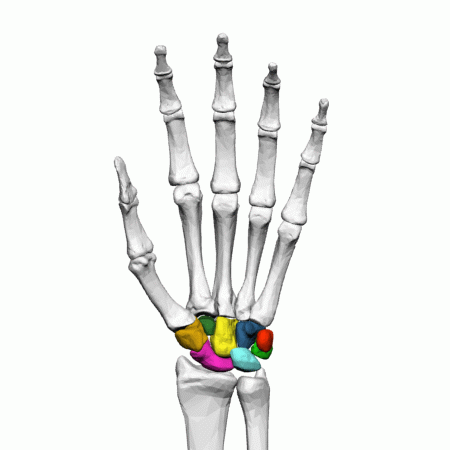Wrist/Hand Assessment

Learn
Introduction 
The wrist is one of the most complex anatomical structures and features eight bones that are collectively known as the carpus or carpal bones. The carpus is comprised of the scaphoid, lunate, triquetrum, pisiform, trapezium, trapezoid, capitate, and hamate.
Moving distally, we will have the metacarpals and phalangeals, as well as the distal radius and ulna.
Epidemiology
Wrist and hand pain is reported to have a point prevalence of about 13% with women being almost twice as often affected as men across all age groups (Picavet et al. 2003).
Course
The Dutch GP Association reports on the course of wrist and hand pain (NHG 2010). The course of wrist and hand pain appears to be unfavorable as only 25% of patients recover after three months and 40% after one year. Prosser et al. (2012) report that patients who received arthroscopy for nonspecific wrist pain had a 50% chance to have moderate levels of pain and low levels of disability one-year post-surgery.
Prognostic factors (Artus et al. 2017, NHG 2010, Prosser et al. 2012)
The following prognostic factors are specifically described for the wrist and hand:
- old age
- female gender
- long duration (>3 months)
- somatisation (+ fracture = increased risk for CRPS)
- less control over pain and function
- baseline Patient-Reported Wrist and Hand Examination (PRWHE)
Furthermore, you should not forget the prognostic factors for general MSK complaints by Artus et al.:
- widespread pain
- high functional disability
- somatization
- high pain intensity
- presence of previous pain episodes
Red flags
There are several specific pathologies that count as red flags. These are:
Fractures
Common fractures are those of the scaphoid, distal ulna, and distal radius.
Distal radius fractures are:
- Smith fractures: distal head of the radius fractures with volar angulation of the fragment(s)
- Colles fractures: Most common after FOOSH (fall on an outstretched hand) trauma. Impact of the scaphoid on the distal radius leads to fracture and dorsal angulation of the radial fragment(s)
Karaca et al (2016) developed the Karadeniz Wrist Rule to screen for fractures of the wrist. Check the video below to learn how to do them.
Ligament Lesions
“Gamekeeper’s thumb/ski pole thumb” (Opposition trauma)

Usually due to a fall: when skiing, the thumb may be injured in a fall, caught in the ski pole loop. “Gamekeeper’s thumb” refers to an old task that Scottish gamekeepers had to do, which led to repetitive strain on the ulnar collateral ligament (UCL) of the thumb. In severe cases, the UCL displaces proximal and superficial to the adductor aponeurosis. This is called a Stener Lesion (Christensen et al. 2016)
Signs & Symptoms include:
- Pain
- Ecchymosis of the thumb MCP
- Weakness of pinch grasp
Scapholunate (SL) ligament lesion
Signs & symptoms include:
- Clicking and pain on the dorsoradial aspect of the wrist
- Clear wrist trauma in history
- Swelling
- Diminished grip strength & reduced ROM
Vascularization issues / Decalcification
- SNAC: Scaphoid Non-Union Advanced Collapse (due to non-healed scaphoid fracture)
- SLAC: Scaphoid-Lunated Advanced Collapse (due to ruptured SL-ligament)
Signs and symptoms include:
- Wrist pain
- Dorsoradial swelling
- Limited ROM
- Tenderness of the radiocarpal and mid-carpal joint
Basic Assessment
Let’s start with active range of motion:
Standard values for the range of motion in different directions are as follows:
AROM assessment is then typically followed by Passive Range of Motion Assessment (PROM) that you can watch with a click on the following video:
During PROM assessment, it’s important to compare the range of motion as well as the end-feel of the affected with the unaffected side.
Specific Pathologies in the Wrist & Hand
There are several pathologies that are commonly seen in the wrist & hand. For more information, click on the respective pathology (content will be added in the near future):
- Carpal Tunnel Syndrome
- De Quervain’s Disease
- Triangular Fibrocartilage Complex (TFCC) Lesions
- Intercarpal Instability
- Impaired Blood Flow & Vascularization
References
Accredited online physiotherapy courses
- Built by the experts at Physiotutors
- Best price per CEUs/CPD Points
- Accredited in the Netherlands, Belgium, Germany, USA, UK, & Australia
- Learn anywhere, any time, and at your own pace!








